| |

Traditions, folklore, history and more. If it's Irish, it's here. Or will be!
"People will not look forward to posterity who never look backward to their ancestors."
-Edmund Burke




Quotes
Library: Books, Movies, Music
Prints & Photos
Poetry
Jokes


Shops Ireland
Bunús na Gaeilge
(Basic Irish)
Circle of Prayer
Blessings
Did You Know?
Himself/Herself
Write to Us
Readers Write..
Links/Link to Us
Advertise with us
Awards & Testimonials
Submissions Guide

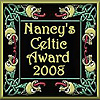
|
|
|
Culture Corner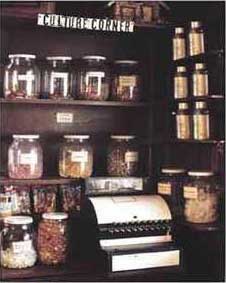
Page 2
Many subscribers and readers have written to ask if they can see our top right corner culture bits. So, we saved them and we're proud to show them here.
 Ilnacullen, Co. Cork - an Island Garden Ilnacullen, Co. Cork - an Island Garden
Located in the sheltered harbour of Glengarriff in Bantry Bay. Ilnacullin, which means island of holly, is a small island known to horticulturists and lovers of trees and shrubs all around the world as an island garden of rare beauty.
The vivid colours of Rhododendrons and Azaleas reach their peak during May and June, whilst the hundreds of cultivars of climbing plants, herbaceous perennials and choice shrubs dominate the midsummer period from June to August.
Because of its sheltered situation and the warming oceanic influence of the Gulf Stream, the climate is favourable to the growth of ornamental plants from many parts of the world.
Even for those who aren’t particularly interested in gardens, there are many other scenic views, especially in the surrounding waters where seals frequent the rocks on the southern shore.
The cover photo on Bridget's book The Traditional Irish Wedding shows a wrought iron garden gate on Ilnaculen. I took that photo. To see it, go to the home page. It's part of the opening paragraph Failte.
—Russ
Resource: Copy and Image - Cork Guide
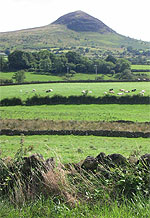 Slemish Mountain Slemish Mountain
Situated in the Braid Valley near Ballymena,Co. Antrim, Slemish Mountain is approximately 1,500 ft above sea level.
Ireland's patron saint is thought to have walked these slopes for six years after being taken into slavery at the age of 16. He worked for a master named Miliucc, herding swine and sheep. And according to his writings, it was here that St Patrick turned to prayer as his only consolation. He escaped, became a priest and began his mission to convert the Irish to Christianity.
Wild flowers, some rare, grow on the grassy slopes. From the top, if you look north, you will see the ruins of Skerry Church on a hilltop where Miluicc’s fort once stood. This was the ancient burying place of the O’Neill’s of Clandeboye.
Slemish is still a place of pilgrimage in memory of Saint Patrick on his feast day - 17 March.
Image and copy: Northern Ireland Landscapes
 Ireland's Most Haunted Castle Ireland's Most Haunted Castle
South-east of Birr between Kinnity and Roscrea, in Co. Offaly are the remains of Leap Castle. Originally an O'Carroll fortress, it guarded the pass from the Slieve Bloom into Munster. Said to have more than 50 ghosts, its dark and mysterious past includes the murder of a priest by his brother in the "Bloody Chapel" and the slaughter by their Irish employers of more than 50 Scots mercenaries in order to avoid payment. It has always had a reputation of being haunted and locals have described seeing the windows at the top of the castle "light up for a few seconds as if many candles were brought into the room" late at night. For more details read our article Creepy Irish Castles & Houses.
Photo Credit & More Details: H. J. Moncrieff
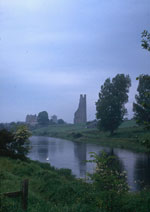 The Battle of the Boyne The Battle of the Boyne
No Irish battle is more famous than William III's victory in 1690 over James II at the River Boyne. It is recalled each July in the celebrations of the Orange Order, not on the first day but on "the Twelfth", for eleven days were lost with the change from the Julian to the Gregorian calendar in 1752. By mid-afternoon on that fateful July 1st, the Jacobite army was in retreat, outpaced by James himself, who rode to Dublin to warn the city of William's approach. He was in France before the month was out.
On July 6th, William entered Dublin, where he gave thanks for victory in Christ Church Cathedral. For an excellent write-up of all the details, visit Ireland’s Eye.
The information is from the book A Little History of Ireland by Martin Wallace.
Photo Credit: Cynthia Austin at Celtic Connection
 Hallowe'en Customs Hallowe'en Customs
(Kids Ireland)
In Ireland long ago, there were no pumpkins. For Hallowe'en, the people would carve out a turnip. Immigrants to America brought this tradition with them, but they quickly discovered that a big, bright orange pumpkin made a much better "Jack O' Lantern!" Other customs they brought with them were games such as Snap Apple and Ducking or Bobbing for Apples. Irish children didn't go Tricking or Treating as we know it; but they did receive gifts of apples and nuts from their friends and relatives. They also enjoyed eating Colcannon, a dish made from potatoes and cabbage, and for dessert, they often had apple dumplings or Stampy cakes made from potatoes and flavored with sugar, caraway seeds and cream.
Carved Turnip from University of British Columbia
 The Galway Hooker The Galway Hooker
This unique vessel, with its distinctive curved lines and bright red sails, originated in the village of Claddagh. During the 19th century, hookers supported a significant fishing industry and also carried goods, livestock and fuel. Seán Rainey is remembered for building the last of the original boats, the Truelight, for Martin Oliver who was to become the last king of the Claddagh; as king, he was entitled to white sails on his boat. Since the mid seventies, many of the old sailing craft which were on the verge of extinction have been lovingly restored and new ones have been built. During the summer months they can be seen at festivals such a Cruinniú na mBád - the Gathering of the Boats - in Kinvara.
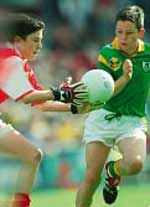 Gaelic Football Gaelic Football
(Kids Ireland)
Gaelic Football has been played in Ireland for many, many years, but it wasn’t until the Gaelic Athletic Association (GAA) was formed on November 1, 1884 that it was played between county teams with proper rules. It is a fast and exciting game that is unique to Ireland and it can best be described as a mixture of soccer and rugby. There are 15 players on a team and the ball they use is round and slightly smaller than a soccer ball.
Today, the game is played in more than 3,500 primary Irish schools.
To learn all about Irish football, other Irish sports and the GAA, we found a great site- the official GAA site just for boys and girls: Kids Football.
 St. Colman's Cathedral St. Colman's Cathedral
Overlooking the harbour in Cobh, Co. Cork, it was one of the last images of Ireland that could be seen by emigrants sailing to America. Designed by the architects Pugin and Ashlin, construction began in 1868 and it was completed in 1915. One year later, a carillon of 47 bells was installed. The biggest bell is 200 feet above the ground and weighs 3.5 tons. The carillon itself is the largest one in Ireland. To hear a simple tune, please click: Carillion Chimes.
Image from All Travel Ireland.
 Playing Irish Music Playing Irish Music
(Kids Ireland)
Music is very important to the Irish and many people, young and old, can play the tin whistle, fiddle, bodhrán, or the uillean pipes; these are the four leading instruments for creating the traditional music of Ireland.
The tin whistle (or pennywhistle) is very popular because it's cheap to buy and easy to learn. The uillean pipes are another wind instrument, but they are very difficult to learn. The bodhrán (pronounced bow-rawn) is a small drum which is made by stretching goatskin over a round frame. It makes a lovely noise! The fiddle is the most popular of all instruments for playing Irish music, but it takes a long time to learn how to play it well.
Image: Bodhrán Tin Whistle
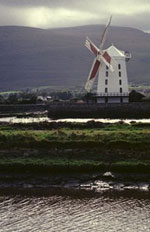 Blennerville Blennerville
At the beginning of the 19th century, there were over 100 working windmills in Ireland. Now only 3 survive - Blennerville, in Co. Tralee, and its sister mills at Ballycopeland, Co. Down, and Tacumshin, Co. Wexford. Blennerville was built about 1800 by Sir Rowland Blennerhassett and in its heyday, it was used for grinding corn for both the locals and for export. However, the introduction of steam power marked the end of traditional wind-powered mills and Blennerville fell into disuse. Restoration was begun in 1984 and the site now comprises a Craft Centre, exhibition gallery, audio-visual presentation and a restaurant adjoining the now-working windmill. It is a major tourist attraction in the region.
Image: Keewi Photography
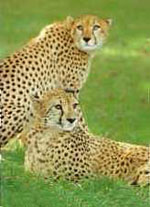 FOTA Wildlife Park FOTA Wildlife Park
(Kids Ireland)
Only 10,000 cheetahs remain in their natural habitat and Fota Wildlife Park in Co. Cork, Ireland, is the world's leading breeder of this endangered species. Fota is among the most modern wildlife parks in Europe. It was opened in 1983 and has more than 70 species living in natural open surroundings with no obvious barriers. Only the cheetahs are behind fences.
Another species which is being saved from extinction at Fota is the white tailed sea eagle. It disappeared from Ireland in the early 1900's, but is now being bred at the park and re-introduced to the wild in Co. Kerry.
Fota is open to the public in the summer and is very popular with Irish families, as well as tourists.
 The Easter Lily Pin The Easter Lily Pin
Symbolic of the emergence and resurrection of a free Ireland, Cumann na mBan (the League of Women) led by Constance Markievicz, popularized the wearing of the Easter Lily pin in 1926 in remembrance for those who gave their lives for the cause of Irish independence during the 1916 Easter Rising. In later years, wearing the pin began to fall out of favor as it became associated more with the IRA than with a symbol of rememberance. However, there is now renewed interest in restoring the wearing of the pin to its original status as a mark of respect and in memory of the many young men and women who died during the rebellion.
If you would like to purchase a Lily Pin, please click Sinn Fein .
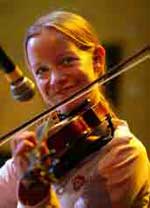 Fleadh Cheoil Fleadh Cheoil
(Festival of Music)
The first national festival of Irish traditional music was held in Mullingar, Co. Westmeath in 1951. It attracted only a few hundred patrons. Comhaltas Ceoltóirí Éireann was founded in the same year and one of its aims was to make this an important annual event. At its inaugural meeting, it came up with the title of Fleadh Cheoil - Festival of Music (flah KEE-ohl). Within five years, the festival was attracting musicians, singers, and dancers from all parts of Ireland and overseas.
Today, Fleadh Cheoil is an annual weekend of non-stop traditional entertainment with thousands of performers competing in forty categories. To learn more, please click Fleadh Cheoil
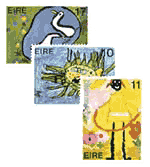 The Texaco Children's Art Competition The Texaco Children's Art Competition
(Kids Ireland)
The competition began in 1955 . Young people in every Irish primary and secondary school were invited to submit their artwork. The reward for the winners was a trip to Dublin to receive their prizes.
Back then, life was simpler. No TV. No video games. For entertainment, children read comic books, skipped rope, spun tops, played football, built soap box carts - and used their imagination. For the children of the 1950s, the competition was really special ... really different! And so it has been ever since. Today, it's still a highlight of the year for thousands of young people in Ireland. Read more about the competition here: Texaco Child Art.
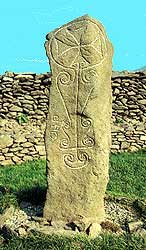 Reask Reask
Early Monastic Site
Reask is situated about a mile outside Ballyferritor on the main Dingle road. It is one of the most thoroughly investigated sites of its type and consists of an enclosing wall, oratory, graveyard with slab shrine, several beautifully engraved cross-slabs and half a dozen circular cells or clochauns. Carbon dating indicates construction began as early as the 4th and 5th century. Finds show evidence of of iron, bronze and possibly glass-working, as well as wool-spinning.The turn-off for the site is beside Brick's Pub, where one of the best pints of Guinness in Corca Dhuibhne can be consumed while mulling over the virtues of the simple monastic life.
Image & Info: Dingle Region.
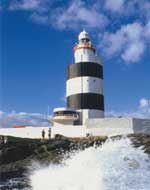 Hook Lighthouse Hook Lighthouse
Ireland's coastline measures more than 3,000 miles , much of it ruggedly beautiful - and treacherous. Protecting ships and sailors are many noble sentinels, including a medieval structure that is said to be be one of the oldest operational lighthouses in the world.
The 13th-century Hook Lighthouse in Co. Wexford was a major feat at the time of its construction. Originally tended by monks, it it is still almost intact. The present lantern was built in 1864, and converted to electricity in 1972. It soars 46 meters above high water and has a range of 23 nautical miles.
According to legend, Dubhán , a sixth-century Welsh monk, established the first light on Hook Head after discovering the bodies of shipwrecked sailors on the rocks.
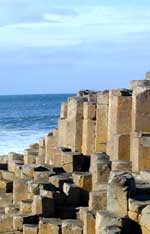 The Giants Causeway The Giants Causeway
(Kids Ireland)
Over the Causeway as a whole there are around 37,000 stone columns mostly 6-sided but some with 4, 5, 7 and 8 sides. They were made about 60 million years ago by the cooling and shrinking of molten lava from a vast volcanic eruption which formed the Antrim Plateau.
One of Ireland's most famous attractions. there is a coastal path provided which stretches about 8km (or nearly 5 miles) long from the entrance to the Causeway to beyond Dunseverick near Whitepark Bay.
Content edited and adapted from Kool Kids of Ireland, a site created by the 3rd Class, St.Patrick's National School, Whitechurch, Co.Cork.
 Holly and Ivy hanging up and Holly and Ivy hanging up and
something wet in every cup*
Not so long ago, Irish Christmas decorations were much simpler than they are now. The children gathered holly and ivy for adorning, windows, doorways, mantles and pictures, and the father would carve out a turnip in which would be placed a large red candle. This would go in the window to light the way for the Holy Family on Christmas Eve. Only in relatively recent times did an Irish family have a Nativity scene and a decorated tree in the house. As for Mistletoe, it's quite rare in ireland and is generally associated with ancient Celtic and Druidic fertility celebrations; this is most likely where the custom of kissing under the mistletoe comes from.
*Old Irish Christmas toast
Image: Pashley Manor Gardens.
 The Cork Butter Market The Cork Butter Market
The Market opened in 1770 and by 1892 it was exporting half million caskets of butter yearly. Early every week-day morning, streets were busy with horse-drawn carts bringing butter from West Cork and Kerry along routes known as butter-roads, or carting it away to local factories and waiting steamships.
Butter was brought in wooden caskets called "firkins". Made of oak, sycamore or good hardwood. the best were Cork-made and they were compulsory for butter going to the tropics.
The Market closed in 1924 and the building became a hat factory; it was destroyed by fire and lay derelict for years . It has since been restored and has become a popular tourist attraction. For more information please click Cork Butter Market.
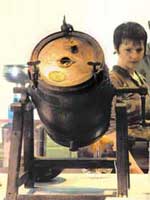 The Cork Butter Museum The Cork Butter Museum
(Kids Ireland)
Have you ever seen a cask of butter that is over a thousand years old? It was found in an Irish bog and is now on display at the Cork Butter Museum. The museum is a popular tourist attraction which celebrates one of the great success stories of Ireland, the butter trade. Here, you can learn how butter is made, how important butter was to families in everyday life and the importance of the butter market in nineteenth century Ireland, especially in the city of Cork. Through a combination of videos, implement displays, maps, documents and other artifacts, story of of butter in Irish history is vividly brought to life! For details please click Cork Butter Museum.
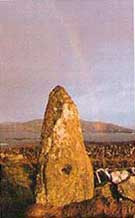 Trysting Stones Trysting Stones
Centuries ago, before wedding ceremonies moved from the bride's house to the church steps, and finally into the church itself, the joining of a couple was often conducted in a place of mystical significance. On Cape Clear, Co. Cork, there is a townland called Comillane where you'll find a pillarstone known as Cloch na Gealluna - 'The Trysting Stone'. It has a hole right through it and in pre-Christian times, a couple would join hands through the stone and in the presence of the local king, they would wed. Similarly, at Kilmaolcheader church near Dingle, Co. Kerry, stands a pillar with a circular opening near the top. It's said that a couple is engaged if they join hands through the opening.
For more please click Baltimore, West Cork.
 Dogs of Ireland - the Kerry Blue Terrier Dogs of Ireland - the Kerry Blue Terrier
(Kids Ireland)
Kerry Blue Terriers were developed over 300 years ago by Irish shepherds. Their name comes from the county of Kerry in south-western Ireland.
Gentle, lovable and intelligent they are very hard working. They can herd sheep and cattle, hunt for rats and other vermin and they are good retrievers.
When they are born, they are black. As they get older, their curly coats change to red, brown or gray and then finally to bluish-grey.
Outgoing and friendly towards their family, they are known to give big, slurpy kisses. But they are also very protective and make good guard dogs as well as excellent family pets.
Resource: Puppy Dog Web.
 Irish Seals and Selkie Tales Irish Seals and Selkie Tales
(Kids Ireland)
Two types of seals live in Ireland - the grey seal, which has a long snout like a dog's, and the common seal which has a round head. Grey seals live along the west coast; the common seal lives in inlets and on sandbanks. In medieval times, seal-hunting was common. But, most Irish people refuse to kill seals. One tradition says that after they die, fishermen turn into seals. Another legend says that seals shed their skins at night and become human. These are the Selkies; they have webs between their fingers and toes and must obey anyone who takes their oily skins; however, if they ever find their seal skins again, they will return to the sea. But, so the story goes, a Selkie wife will not forget her husband and children and can be seen swimming close to the shore watching over them.
Image: Grey seal swimming off Scattery Island in Co. Clare.
 Hedge Schools Hedge Schools
(Kids Ireland)
Did you know that in Ireland, a long time ago, it was against the law under English rule for an Irish man or woman to be a teacher? But, the Irish have always had a love of learning, so they did whatever they could to educate their children. They created secret places where teachers could teach their students in safety. These became known as "Hedge Schools" because they were often tucked away under hedges in the countryside. Other secret places were under ruined walls, in dry ditches by the roadside, or in old barns. Most of these schools didn't have books, paper or pencils, so the children learned their lessons by listening to the teacher and then repeating the words of the lesson. In this way, many children learned Irish history, traditions, mathematics, even languages such as Latin and Greek!
 Trinity College Trinity College
Founded in 1592, Trinity College was granted the lands of All Hallows monastery, a mile to the south east of the city. For over 200 years, only Protestant students could attend, but then, in 1793, Roman Catholics were allowed in; however, they had to obtain the permission of the Bishop of Dublin. Women were admitted to Trinity College for the first time in 1904. The College library is the largest research library in Ireland. It is entitled legally to a copy of every book published in Britain and Ireland, and contains 4.25 million books. The Book of Kells is the library's most famous work. Notable alumni include Swift, Goldsmith, Wilde and Beckett.
For a more detailed history, visit Trinity College Visitors.
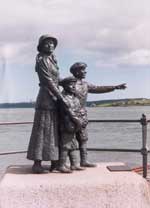 Annie Moore Annie Moore
(Kids Ireland)
This statue of Annie Moore - the first immigrant to pass through Ellis Island - stands on the dock in Cobh. Co. Cork. She looks back towards the home she is leaving while her brothers look out to sea and, beyond the horizon, the New World, three thousand miles away.
Annie set off for America from here aboard the S.S. Nevada, on December 20th, 1891. Imagine how excited and nervous she must have been when she and her brothers arrived in New York on January 1, 1892. As the very first of 700 immigrants to disembark from her ship and two other boats that day, she was given a wondrous welcome - and also a $10.00 gold coin!
 Carrick-a-Rede Rope Bridge, Co. Antrim Carrick-a-Rede Rope Bridge, Co. Antrim
This unique span links the tiny island of Carrick-a-Rede with the dramatic Giant’s Causeway coast. The name means ‘the rock in the road’ and refers to the sea route salmon use to migrate to home waters. Hundreds of years ago, while there was plenty of fish to catch, casting a net from a boat was perilous due to rough seas and rocky shores. The solution was a simple rope bridge built by local fishermen. Once a single-railed bridge with wide gaps between the slats, it is now double-railed gapless. However, crossing the bridge is not for the faint-hearted. Downwards is an 80-foot panorama of sand, sea and surf. If you can’t walk, across, there’s a special platform which also affords spectacular views.
Photo Credit : © Keewi Photography
 Conkers! Conkers!
(Kids Ireland)
When the trees start to change colour in the Autumn, it means the "conker" season is upon us. "Conkers" are the seeds, in the form of nuts, of the Horse Chestnut tree. A green spikey seed pod falls to the ground and eventually, this splits open to reveal a shiny brown nut. This “conker” can be used for a game of the same name that’s played in many countries including Ireland. Players drill a hole through the middle of the nut , thread a string through, knot it and then proceed to take alternate blows at the opponent's "conker". The winner is the one who breaks the opponent's "conker". For details on how to play the game, including rules, please click Wikipedia.
Photo Credit: Dylan Vaughan
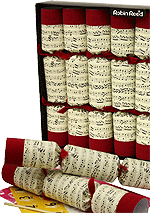 Christmas Crackers Christmas Crackers
(Kids Ireland)
No Christmas dinner in Ireland would be complete without the fun of finding a Christmas Cracker by your plate. And, no, it's not something you eat! These crackers are tubes covered with brightly coloured foil. Each tube is usually filled with a paper hat, a silly toy, a joke and a strip of paper which will make a pop when the cracker is pulled. Each end of the tube is twisted so the treats inside won't fall out. The fun begins when each cracker is pulled by two people and the cracker splits. In many homes, the crackers are pulled before dinner begins so that families can wear the funny paper hats throughout the meal. In other homes, the crackers are pulled after dinner. No matter when they're pulled, crackers always make the Christmas feast more fun.
Photo Credit & for a wide selection: Amazon
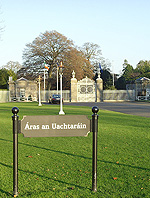 Áras Kids Áras Kids
This is part of the official website of the President of Ireland and was created just for kids. It's a fun place where young people from different cultures, backgrounds and traditions can come together to learn about the President, as well as an Uachtaráin, the house where the President lives. It is located in the Phoenix Park, the largest public park in Europe. Children can also learn about how the President represents the Irish people every day and ask questions about her role.
And you can play games throughout your tour. Enjoy your visit!
Click Aras Kids
Photo Credit: Flicker/ebel
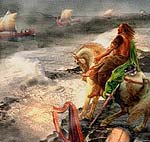 Brian Boru-Ireland's greatest King Brian Boru-Ireland's greatest King
BrianBoru was born around 940, the youngest of two sons of Cennedig, head of Dal Cais, one of the royal free tribes of Munstrer. When the Danes began to overrun the country, the two brothers united, and swept them back inside their walled cities.Of the two brothers, Brian was more forceful, capable and energetic. When Malachi was killed by treachery, Brian was undisputed king. He reigned for thirty-nine years.
It was a time of unsurpassed glory, prosperity and happiness. He promoted the arts and learning. He is credited with having originated surnames. His patriotism and personal sacrifice brought the clans together, under one king, for the only time in Irish history.
He was eighty-nine when his army faced the armies of the Norsemen at the
Battle of Clontarf. Brian's warriors won the day, but Brian was dead, as were his son and grandson. The days of Ireland's finest king were gone.
In the words of his eulogist, "Brian was the last man in Erin who
was a match for a hundred."
Sources: Irish Story Teller
Clare County Library
The General Post Office
The General Post Office (GPO) (Irish: Ard-Oifig an Phoist) in Dublin is the headquarters of the Irish postal service, An Post, and Dublin's principal post office. Centrally located on O'Connell Street, the city's main thoroughfare, it is one of Ireland's most iconic buildings, and was the last of the great Georgian public buildings erected in the capital. thoroughfare, it is one of Ireland's most iconic buildings, and was the last of the great Georgian public buildings erected in the capital.
During the Easter Rising of April 1916, the GPO served as the headquarters of the uprising's leaders. The assault by the British forces extensively damaged the building and the original columns outside are still pocked with bullet-marks.The building remains a symbol of Irish nationalism and an original print of the Proclamation of the Irish Republic read by Padraic Pearse is on permanent display in the GPO philatelic office. A plaque commemorates the exact spot where he read the proclamation.
Source: GPO Museum
Photo Credit: GPO/Mikvs
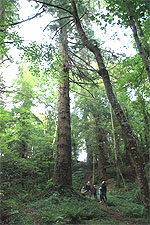 Ireland's tallest tree Ireland's tallest tree
A Douglas Fir at Powerscourt in Co Wicklow has been officially recognised as the tallest tree in Ireland since records began by leading tree expert, Aubrey Fennell. The tree stands at 61.5 metres, or 202 ft, towering above well-known landmarks including Dublin’s Liberty Hall (59.5 metres) and Niagara Falls (51m). It is the first tree to surpass 60m in Ireland and is the seventh-highest tree in Europe. Located along Powerscourt River Walk, the tree is open to the public through annual membership of Powerscourt, and to guests staying at the Powerscourt Hotel. They are very privileged to access glorious woodland trails and Ireland’s own ‘Avenue of Giants’ which rivals all other contenders in Europe.
Photo Credit & Copy: Powerscourt
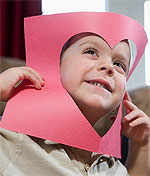 Valentine's Day in Ireland Valentine's Day in Ireland
(Kids' Ireland)
All over the world, Valentine's Day is celebrated with flowers, chocolates and cards. But in Ireland, it's even more special. In 1836, a relic of St. Valentine was sent by Pope Gregory to the Carmelite Church in Dublin. Every year since then, on Valentine's Day, a casket containing the relic is carried in a procession to the high altar for a special Mass dedicated to young people and those in love. If you're lucky enough to be there, this little known Dublin church also sells Valentine's Day cards. But if you're like most young people, it's much more fun to give cards you've made yourself.
Photo Credit: Early Childhood Ireland
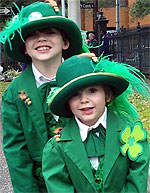 Wearing green Wearing green
on St Patrick's Day
(Kids' Ireland)
You might be surprised to learn that in Ireland, not so long ago, about the only green you would see adults wear on St. Patrick's Day was fresh shamrock which was pinned onto a lapel or tucked into a cap or hat. And children probably didn't wear any green at all, except for the small amount included as a color on special St. Patrick crosses which they made themselves and wore to mass on St Patrick's Day morning. How different it is today! People all over the world love to dress up in all kinds of wild outfits, especially if they are going to a parade. Even in Ireland, the day has become a splashy festival like Mardi Gras in New Orleans - especially in Dublin - and very few people think of it as the religious holiday it once was.
Photo Credit: Trend Photos
ED.NOTE: Photo source includes coloring pages
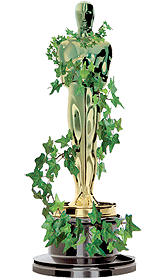 The Irishman who designed The Irishman who designed
the Oscar satuette
Ireland’s first and most lasting contribution to the Academy Awards is at the ceremony’s very heart: the Oscar statuette was designed by Dublin- born Cedric Gibbons, an art director with Metro-Goldwyn-Mayer, who also became Ireland’s first winner. Although his first Oscar (for art direction on The Bridge of San Luis Rey) was the only award he received individually, Gibbons was nominated for 38 Academy Awards and received 11 Oscars. By most yardsticks, this record makes Gibbons the most successful Irish Oscar winner in history.
Source: The Irish Times
Photo Credit: Hollywood Confidential
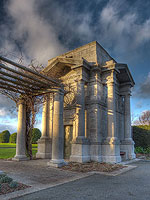 Irish National War Memorial Gardens Irish National War Memorial Gardens
Not to be confused with the Garden of Remembrance in Dublin, the Irish National War Memorial Gardens - Gairdíní Náisiúnta Cuimhneacháin Cogaidh na hÉireann - in Irish, is an Irish war memorial in Islandbridge, Dublin, dedicated "to the memory of the 49,400 Irish soldiers who gave their lives in WWI. The gardens also commemorate all other Irish men and women who at that time served, fought and died in the Irish regiments of the Allied armies.
Copy Source & Photo Credit: Wikipedia
Previous Culture Corner - Page 1
|
|
Thu, Apr 4, 2024
 Ilnacullen, Co. Cork - an Island Garden Ilnacullen, Co. Cork - an Island Garden
Located in the sheltered harbour of Glengarriff in Bantry Bay. Ilnacullin, which means island of holly, is a small island known to horticulturists and lovers of trees and shrubs all around the world as an island garden of rare beauty.
The vivid colours of Rhododendrons and Azaleas reach their peak during May and June, whilst the hundreds of cultivars of climbing plants, herbaceous perennials and choice shrubs dominate the midsummer period from June to August.
Because of its sheltered situation and the warming oceanic influence of the Gulf Stream, the climate is favourable to the growth of ornamental plants from many parts of the world.
Even for those who aren’t particularly interested in gardens, there are many other scenic views, especially in the surrounding waters where seals frequent the rocks on the southern shore.
The cover photo on Bridget's book The Traditional Irish Wedding shows a wrought iron garden gate on Ilnaculen. I took that photo. To see it, go to the home page. It's part of the opening paragraph Failte.
—Russ
Resource: Copy and Image - Cork Guide
Click for More Culture Corner.

Celtic Bookmark
Elegant bookmark is made of silver over pewter. It measures 3" x 1". When in use, the pretty Celtic design sticks out of your book. Or choose Trinity Knot or Celtic Heart.
Click for Celtic Book mark.
|
|
|




 Ilnacullen, Co. Cork - an Island Garden
Ilnacullen, Co. Cork - an Island Garden